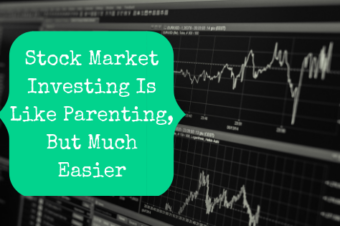
If you’ve been paying any attention to the news (and I don’t blame you if you haven’t), you’re probably aware that the stock market has been very active lately. Active like a volcano. You see headlines like “Stocks Lose 34% in One Month” and “Stocks Jump 2%.” What does it all mean, though? Do you really understand what they’re talking about?
What Do We Mean By The Stock Market?
First of all, what is the stock market? Stocks are portions of ownership in publicly traded companies. They can be bought and sold on exchanges, or markets. When people talk about the stock market, they are usually referring to the valuation of stocks. When they talk about the market going up or down, they mean that overall stock prices are going up and down.
If that’s as clear as mud, read my more in-depth explanation of the stock market here. For the sake of this article, you just need to understand that the stock market refers to all stocks all over the world, which is really hard to measure. There are so many publicly traded companies in the US alone that just measuring the US stock market is a challenge.
To overcome this challenge, it is common to use a stock index, or fixed group of stocks, as a proxy to represent the stock market as a whole. One of the most popular ones is the S&P 500, which is made up of the largest 500 or so companies in the US. We can look at the S&P 500’s behavior and infer how the rest of the US stocks are doing.
What The Stock Market Has Done In 2020
Here is a graph of what the S&P 500 has done so far this year:
Looks like a bumpy roller coaster ride, doesn’t it? That’s exactly how it felt for many investors. The S&P 500 reached a new record high on February 19, 2020. And then came the free fall. In a little over a month, between February 19 and March 23, the S&P 500 lost 34% of its value. That’s the big jagged drop that you see.
Since then, stocks have staged a remarkable comeback, rising in value by 36% as of May 27. That’s the date I will use for all of these calculations because I’m being good this week and not waiting until the last minute to write this!
What All The Numbers Mean
If stocks dropped 34% and then rose again by 36%, why isn’t the right side of the graph higher than the left side?
The percentages don’t add up because they are based on different numbers. On February 19, the S&P 500 reached a high of 3,386.15 points. Then it lost 1,148.75 points and bottomed out at 2,237.40. To calculate the percentage of value it lost, divide the loss by the starting point:
1,148.75 / 3,386.15 = 34%
After bottoming out at 2,237.40, the S&P 500 has since gone up by 798.73 points to 3,036.13. This growth is reported as a percentage of where it is growing from. So, to calculate the growth, you divide the gain by the starting point:
798.73 / 2,237.40 = 36%
As you can see, the percentages don’t add up because they are based on different numbers. Overall, the S&P 500 is still down 10% from where it was on February 19. Hence the equation in the title of this article: -34 + 36 = -10. The stock market dropped 34%, recovered 36%, but is still down by 10%. All because of how the numbers are calculated.
So, as you see news headlines throwing out percentages for stock market returns, don’t think you can use basic arithmetic to make sense of it all. You have to look a little bit deeper to really understand what they are talking about.



